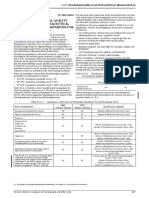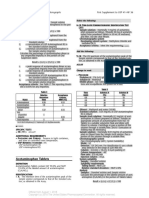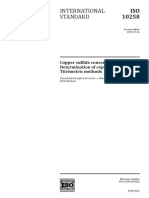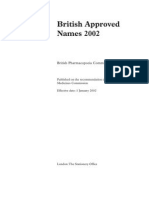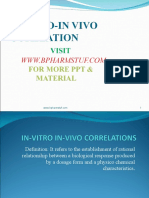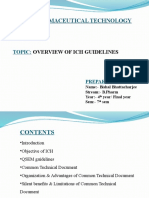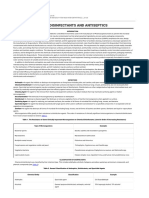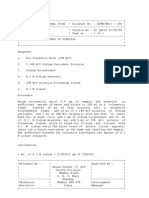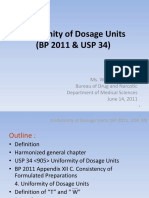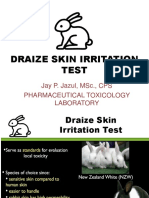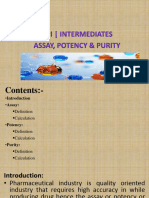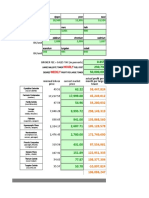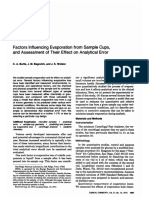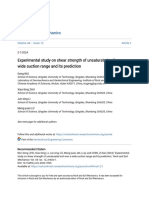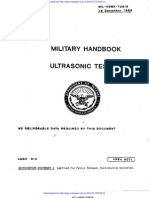British Pharmacopoeia 2009 ...
British Pharmacopoeia 2009 ...
Uploaded by
Raymond Yuwei YuanCopyright:
Available Formats
British Pharmacopoeia 2009 ...
British Pharmacopoeia 2009 ...
Uploaded by
Raymond Yuwei YuanCopyright
Available Formats
Share this document
Did you find this document useful?
Is this content inappropriate?
Copyright:
Available Formats
British Pharmacopoeia 2009 ...
British Pharmacopoeia 2009 ...
Uploaded by
Raymond Yuwei YuanCopyright:
Available Formats
British Pharmacopoeia 2009 Online
http://www.pharmacopoeia.co.uk/bp2009/ixbin/bp.cgi?a=print&id=5...
British Pharmacopoeia Volume III Formulated Preparations: Specific Monographs
Paracetamol Tablets
General Notices
Action and use Analgesic; antipyretic. DEFINITION Paracetamol Tablets contain Paracetamol. The tablets comply with the requirements stated under Tablets and with the following requirements. Content of paracetamol, C8H9NO2 95.0 to 105.0% of the stated amount. IDENTIFICATION Extract a quantity of the powdered tablets containing 0.5 g of Paracetamol with 20 ml of acetone, filter, evaporate the filtrate to dryness and dry at 105. The residue complies with the following tests. A. The infrared absorption spectrum, Appendix II A, is concordant with the reference spectrum of paracetamol (RS 258). B. Boil 0.1 g with 1 ml of hydrochloric acid for 3 minutes, add 10 ml of water and cool; no precipitate is produced. Add 0.05 ml of 0.0167M potassium dichromate; a violet colour is produced slowly which does not turn red. C. Melting point, about 169, Appendix V A. TESTS Dissolution Comply with the requirements for Monographs of the British Pharmacopoeia in the dissolution test for tablets and capsules, Appendix XII B1, using Apparatus 2. Use as the medium 900 ml of phosphate buffer pH 5.8 and rotate the paddle at 50 revolutions per minute. Withdraw a sample of 20 ml of the medium and filter. Dilute the filtrate with 0.1M sodium hydroxide to give a solution expected to contain about 0.00075% w/v of Paracetamol. Measure the absorbance of this solution, Appendix II B, at the maximum at 257 nm using 0.1M sodium hydroxide in the reference cell. Calculate the total content of paracetamol, C8H9NO2, in the medium taking 715 as the value of A(1%, 1 cm) at the maximum at 257 nm. Related substances Carry out the method for liquid chromatography, Appendix III D, using the following solutions. Prepare the solutions immediately before use and protect from light. For solution (1) disperse a quantity of powdered tablets containing 0.2 g of Paracetamol in 8 ml of the mobile phase with the aid of ultrasound, add sufficient mobile phase to produce 10 ml, mix well and filter. For solution (2) dilute 1 volume of solution (1) to 20 volumes with mobile phase and dilute 1 volume of this solution to 20 volumes with mobile phase. Solution (3) contains 0.002% w/v each of 4-aminophenol and paracetamol BPCRS in the mobile phase. Solution (4) contains 0.00002% w/v of 4-chloroacetanilide in the mobile phase. The chromatographic procedure may be carried out using (a) a stainless steel column (25 cm 4.6 mm) packed with octylsilyl silica gel for chromatography (5 m) (Zorbax Rx C8 is suitable), (b) as the mobile phase with a flow rate of 1.5 ml per minute, at a temperature of 35C, a mixture of 250 volumes of methanol containing 1.15 g of a 40% v/v solution of tetrabutylammonium hydroxide with 375 volumes of 0.05M disodium hydrogen orthophosphate and 375 volumes of 0.05M sodium dihydrogen orthophosphate and (c) a detection wavelength of 245 nm. The test is not valid unless, in the chromatogram obtained with solution (3), the resolution factor between the two principal peaks is at least 4.0. Inject solution (1) and allow the chromatography to proceed for 12 times the retention time of the principal peak. In the chromatogram obtained with solution (1) the area of any peak corresponding to 4-aminophenol is not greater than the area of the corresponding peak in solution (3) (0.1%), the area of any peak corresponding to 4-chloroacetanilide is not greater than the area of the principal peak in solution (4) (10 ppm) and no other impurity is greater than the area of the principal peak obtained with solution (2) (0.25%).
1 of 2
27/10/2009 10:23
British Pharmacopoeia 2009 Online
http://www.pharmacopoeia.co.uk/bp2009/ixbin/bp.cgi?a=print&id=5...
ASSAY Weigh and powder 20 tablets. Add a quantity of the powder containing 0.15 g of Paracetamol to 50 ml of 0.1M sodium hydroxide, dilute with 100 ml of water, shake for 15 minutes and add sufficient water to produce 200 ml. Mix, filter and dilute 10 ml of the filtrate to 100 ml with water. Add 10 ml of the resulting solution to 10 ml of 0.1M sodium hydroxide, dilute to 100 ml with water and measure the absorbance of the resulting solution at the maximum at 257 nm, Appendix II B. Calculate the content of C8H9NO2 taking 715 as the value of A(1%, 1 cm) at the maximum at 257 nm. STORAGE Paracetamol Tablets should be protected from light. Crown Copyright 2008
2 of 2
27/10/2009 10:23
You might also like
- European Pharmacopoeia (Ph. Eur.) 10th Edition - RenewalsDocument3 pagesEuropean Pharmacopoeia (Ph. Eur.) 10th Edition - RenewalsYaseminNo ratings yet
- Crospovidone EP 10.6 PDFDocument2 pagesCrospovidone EP 10.6 PDFxuan y phanNo ratings yet
- (Analytical Profiles of Drug Substances 11) Klaus Florey (Eds.) - Academic Press (1982) PDFDocument661 pages(Analytical Profiles of Drug Substances 11) Klaus Florey (Eds.) - Academic Press (1982) PDFngochieu_909No ratings yet
- 2.2.3. Potentiometric Determination of PHDocument2 pages2.2.3. Potentiometric Determination of PHMinh Anh NguyễnNo ratings yet
- British Pharmacopoeia Volume IIIDocument2 pagesBritish Pharmacopoeia Volume IIIQonita Nita0% (1)
- Guideline Qualification of Equipment Annex 9 PH-meter October 2015Document4 pagesGuideline Qualification of Equipment Annex 9 PH-meter October 2015Parkhomyuk50% (2)
- (107.1) Experiment 2 - Milk of MagnesiaDocument5 pages(107.1) Experiment 2 - Milk of MagnesiaReysterCastroNo ratings yet
- Ph. Eur 5.1.4 - Microbiolgical Quality of Non Sterile Pharm PreparationDocument1 pagePh. Eur 5.1.4 - Microbiolgical Quality of Non Sterile Pharm PreparationLuis Sanabria0% (1)
- Usp 43 NF 38 IndexDocument72 pagesUsp 43 NF 38 IndexNumixx SasNo ratings yet
- European Pharmacopoeia 8.0, Vol. 2 - Европейская Фармакопея 8.0, Том 2 (PDFDrive)Document2,133 pagesEuropean Pharmacopoeia 8.0, Vol. 2 - Европейская Фармакопея 8.0, Том 2 (PDFDrive)YuNo ratings yet
- USP 281 ROI Residue On IgnitionDocument2 pagesUSP 281 ROI Residue On IgnitionLisa Debrowski100% (1)
- Paracetamol Tablet USP41Document3 pagesParacetamol Tablet USP41jayvee francisco100% (2)
- Minimum Requirements For Establishment of Pharmacy Institution 17-03-2016Document27 pagesMinimum Requirements For Establishment of Pharmacy Institution 17-03-2016WaqasNo ratings yet
- 0052-0054 (51) Antimicrobial Effectiveness TestingDocument4 pages0052-0054 (51) Antimicrobial Effectiveness TestingDr usama El ShafeyNo ratings yet
- Lab 6 Reflection Refraction OnlineDocument12 pagesLab 6 Reflection Refraction OnlineOmar El ErakiNo ratings yet
- ISO 10258-2015 Copper Sulfide Concentrates-Determination of Copper Content-Titrimetric MethodsDocument26 pagesISO 10258-2015 Copper Sulfide Concentrates-Determination of Copper Content-Titrimetric Methodsxiujia Long100% (3)
- 2.8.13. Pesticide Residues EurPh 7.0Document2 pages2.8.13. Pesticide Residues EurPh 7.0LukmanWibowoNo ratings yet
- Rosuvastatin IP MonographDocument4 pagesRosuvastatin IP Monographvijay PugalNo ratings yet
- Rosuvastatin EP MonographDocument7 pagesRosuvastatin EP MonographJagdish Chander86% (7)
- Japanese Pharmacopoeia XV - JP17Document1,802 pagesJapanese Pharmacopoeia XV - JP17333cubi3330% (1)
- Eucalyptus OilDocument2 pagesEucalyptus Oilsheenali0% (1)
- Farmacopeea Britanica-2002-Structuri Moleculare MedicamenteDocument360 pagesFarmacopeea Britanica-2002-Structuri Moleculare MedicamenteAlina RomanNo ratings yet
- 5.10. Control of Impurities in Substances For Pharmaceutical Use PDFDocument3 pages5.10. Control of Impurities in Substances For Pharmaceutical Use PDFdenisaNo ratings yet
- Standarization of Volumetric SolutionsDocument9 pagesStandarization of Volumetric SolutionsZahid IqbalNo ratings yet
- British PharmacopoeiaDocument12 pagesBritish PharmacopoeiaUsman Ghani100% (1)
- Biological Indicators TOC PDFDocument20 pagesBiological Indicators TOC PDFnsk79in0% (1)
- Usp32 NF27 PDFDocument1,493 pagesUsp32 NF27 PDFJosé Carlos Solís SuárezNo ratings yet
- Patent EP2808010A1 - Syrup Formulation of Salbutamol - Google PatentsDocument5 pagesPatent EP2808010A1 - Syrup Formulation of Salbutamol - Google PatentsMuhammadAmdadulHoque100% (1)
- Korean Pharmacopoeia Up To DateDocument36 pagesKorean Pharmacopoeia Up To DateLuisNo ratings yet
- Quality Control of Herbal Medicines and Related AreasDocument292 pagesQuality Control of Herbal Medicines and Related AreasHarrizul RivaiNo ratings yet
- Calibration of Dissolution Test ApparatusDocument1 pageCalibration of Dissolution Test ApparatusnutrimakeNo ratings yet
- In Vitro in Vivo Correlation 4Document31 pagesIn Vitro in Vivo Correlation 4GANESH KUMAR JELLANo ratings yet
- Ointments and Creams Basics of FormulationDocument4 pagesOintments and Creams Basics of FormulationJai MurugeshNo ratings yet
- Preservative Efficacy Test For Cosmetic Product: 1 Scope and Field of ApplicationDocument5 pagesPreservative Efficacy Test For Cosmetic Product: 1 Scope and Field of ApplicationNukiAdelaNo ratings yet
- ICH (QSEM Guidelines)Document11 pagesICH (QSEM Guidelines)Bishal Bhattacharjee100% (2)
- USP 42 Chapter 1072Document5 pagesUSP 42 Chapter 1072Chetalee Naik100% (1)
- European Pharmacopoeia 8.2 - 2014 - IndexDocument53 pagesEuropean Pharmacopoeia 8.2 - 2014 - IndexRoger (Sisfarma)100% (3)
- 71 Sterility Test Usp41Document8 pages71 Sterility Test Usp41hh_543No ratings yet
- BP2016 - Vol.01Document1,334 pagesBP2016 - Vol.01thu dat80% (5)
- Assay of SorbitolDocument2 pagesAssay of Sorbitolarajamani78100% (1)
- Paracetamol BPDocument4 pagesParacetamol BPjaimurugeshNo ratings yet
- Sop - Hplcchiral-1 - 2 SHIMADZU PDFDocument5 pagesSop - Hplcchiral-1 - 2 SHIMADZU PDFLê Duy ThăngNo ratings yet
- Uniformity of Dosage Units BP 2011 & USP 34Document26 pagesUniformity of Dosage Units BP 2011 & USP 34Anonymous SDUIPeqXNo ratings yet
- Fosfomycin EP PDFDocument2 pagesFosfomycin EP PDFASHOK KUMAR LENKA100% (2)
- Analytical Profiles of Drug Substances Volume 18 1989 PDFDocument643 pagesAnalytical Profiles of Drug Substances Volume 18 1989 PDFchemtabNo ratings yet
- 2.5.11. Complexometric TitrationsDocument1 page2.5.11. Complexometric TitrationsMulayam Singh YadavNo ratings yet
- Metode HPLC Knauer PDFDocument139 pagesMetode HPLC Knauer PDFFiuL Q_renNo ratings yet
- Draize Irritation Test PDFDocument27 pagesDraize Irritation Test PDFhoythereNo ratings yet
- Usp 788Document3 pagesUsp 788Wesley OliveiraNo ratings yet
- Understanding API Assay, Potency, and PurityDocument17 pagesUnderstanding API Assay, Potency, and PurityAngel Flores100% (1)
- USP 2015-Dsc-Chapters-561-616-1010-1092Document54 pagesUSP 2015-Dsc-Chapters-561-616-1010-1092anna100% (1)
- Assay of Ferrous FumarateDocument2 pagesAssay of Ferrous FumarateJilNo ratings yet
- Tablets Quality ControlDocument18 pagesTablets Quality ControlThangabalan Than100% (2)
- EP-Purified WaterDocument3 pagesEP-Purified WaterHECHUANNo ratings yet
- Ibuprofen Tablets - British PharmacopoeiaDocument5 pagesIbuprofen Tablets - British PharmacopoeiaJanavi MotwaniNo ratings yet
- Chapterr 5Document32 pagesChapterr 5gebito67% (3)
- USP 281 Residue On IgnitionDocument1 pageUSP 281 Residue On IgnitionMasood SabirNo ratings yet
- European Pharmacopeia PDFDocument2 pagesEuropean Pharmacopeia PDFRenee0% (1)
- Small Volume Parenterals by MVRR2Document37 pagesSmall Volume Parenterals by MVRR2mvrr9100% (3)
- Multivitamin StabilityDocument5 pagesMultivitamin Stabilityanand1540100% (1)
- Leuprorelin Injection BPDocument4 pagesLeuprorelin Injection BPsuhas.lavhekarNo ratings yet
- Cho 203 Cre - Ii 2023Document5 pagesCho 203 Cre - Ii 2023RashmiNo ratings yet
- 2ndpuc Physics Final QBDocument92 pages2ndpuc Physics Final QBAmit SutarNo ratings yet
- Chapter 9: Linear Momentum and CollisionsDocument18 pagesChapter 9: Linear Momentum and CollisionsSehati FisikaNo ratings yet
- Building Climatology Modul 2Document16 pagesBuilding Climatology Modul 2Ayyappan GouthamanNo ratings yet
- Food Chemistry: XDocument8 pagesFood Chemistry: XGuisela Carbajal RomeroNo ratings yet
- WebinarSPETrisakti PDFDocument21 pagesWebinarSPETrisakti PDFwans116No ratings yet
- Investigating The Parameters of Circular Orbits: Done Done Done Therefore: V 2,988 10 4 M/sDocument3 pagesInvestigating The Parameters of Circular Orbits: Done Done Done Therefore: V 2,988 10 4 M/sAbel RodriguezNo ratings yet
- Earth As A SystemDocument15 pagesEarth As A SystemDondon TayabanNo ratings yet
- January 2013 QP - Unit 2 Edexcel Chemistry A-LevelDocument24 pagesJanuary 2013 QP - Unit 2 Edexcel Chemistry A-LevelNabindra RuwaliNo ratings yet
- Principles of Numerical Weather Prediction and Modeling-7 by Prof.A.S.N.MurtyDocument14 pagesPrinciples of Numerical Weather Prediction and Modeling-7 by Prof.A.S.N.MurtyPantulu MurtyNo ratings yet
- EVE Reactions v4dDocument11 pagesEVE Reactions v4dviktormarkinNo ratings yet
- QualityControl 1 ReviewerDocument15 pagesQualityControl 1 Reviewerprinz1mendezNo ratings yet
- Factors Influencing Evaporation From Sample Cups, and Assessment of Their Effect On Analytical ErrorDocument11 pagesFactors Influencing Evaporation From Sample Cups, and Assessment of Their Effect On Analytical ErrorFerliemNo ratings yet
- Experimental Study On Shear Strength of Unsaturated Soil Over A WDocument13 pagesExperimental Study On Shear Strength of Unsaturated Soil Over A WAsma SamiNo ratings yet
- Expt No. 2-CarbohydratesDocument17 pagesExpt No. 2-CarbohydratesNathaniel PulidoNo ratings yet
- 4.3 Exam QuestionsDocument52 pages4.3 Exam QuestionsRegirocksNo ratings yet
- Is 10810 - 5 - 1984 Ra 2016Document3 pagesIs 10810 - 5 - 1984 Ra 2016Swati SharmaNo ratings yet
- Switch de Flujo FS4-3Document2 pagesSwitch de Flujo FS4-3flacobdpNo ratings yet
- ISO 15397 p3Document4 pagesISO 15397 p3Andres PerezNo ratings yet
- Gmail - FWD - Term PaperDocument2 pagesGmail - FWD - Term PaperSarthak DasNo ratings yet
- Water in Cracked Gas Dryer Vessel Outlets: Application NoteDocument2 pagesWater in Cracked Gas Dryer Vessel Outlets: Application Noteluciole60No ratings yet
- 05 Quarter 0 - Unit 3 Exam-ReguDocument2 pages05 Quarter 0 - Unit 3 Exam-ReguEnrique GarciaNo ratings yet
- Mil HDBK Ultrasonic TestingDocument90 pagesMil HDBK Ultrasonic TestingJoel SequeiraNo ratings yet
- Electrostatic 1Document71 pagesElectrostatic 1emmanuel hauleNo ratings yet
- SCR EspDocument20 pagesSCR EspmuthuNo ratings yet
- 0.2 - Automotive Electronics Council Chair Report 2019 - Update - Tue Oct 15 V2Document16 pages0.2 - Automotive Electronics Council Chair Report 2019 - Update - Tue Oct 15 V2moyinglong1126No ratings yet
- Project Proposal in Pipe Loss ApparatusDocument25 pagesProject Proposal in Pipe Loss ApparatusAnthony Justin EdmaNo ratings yet
- PE and KE Practice KEYDocument2 pagesPE and KE Practice KEYLia FakhryNo ratings yet







